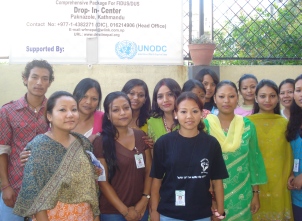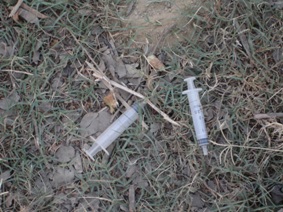On the occasion of International Women's Day, celebrated on 8th March every year, our Office presents the findings of a new study mapping the profiles, drug use patterns and risk behaviors of women drug users in Nepal.
Nepal: New UNODC study maps female drug use in country
 Although the problem of drug use among women is being increasingly recognized, many related issues have not been studied nor addressed when developing responses to drug use and/or HIV/AIDS prevention and treatment for vulnerable groups. This is partly due to the limited numbers of women drug users and the largely subordinate position of women users in the drug subculture.
Although the problem of drug use among women is being increasingly recognized, many related issues have not been studied nor addressed when developing responses to drug use and/or HIV/AIDS prevention and treatment for vulnerable groups. This is partly due to the limited numbers of women drug users and the largely subordinate position of women users in the drug subculture.
Drug use further weakens the disadvantaged position of women, especially in societies with a high degree of gender inequality. It also increases their vulnerability to intimate partner violence, to drug peddling and/or sex work required to sustain their drug habit and with that the risk of health consequences. The stigma and subsequent social isolation is more severe for women compared to male drug users, which often holds them back from reaching out for help. Research indicates that women are likely to suffer worse health consequences than men as a result of drug use. However, most prevention and care programmes for drug users do not reach female drug users because the services are more male-centric.
The drug user survey undertaken in Nepal in 2007 estimated that 7.2% of the drug using population were women[1] and recognized that their issues differ from those of male drug users. Efforts have been made in the past few years to address their needs by setting up female specific drop in centres (DICs) and extending support for free treatment of substance dependence.
Recognising the need for a more comprehensive study on women drug users and related aspects, UNODC, in partnership with the
 Ministry of Home Affairs and the National Centre for AIDS and STD Control, Government of Nepal conducted the study titled
"Profile, Drug use pattern, Risk Behavior and selected bio-markers of women drug users from seven sites in Nepal''. The study aimed to understand the profiles, substance use patterns and risk behaviours of women drug users based on one-to-one interviews and selected bio markers related to Sexually Transmitted Infections (STIs), including HIV. A total of 393 women, including 323 injecting and 70 non injecting drug users, were interviewed across seven sites in Nepal, namely Kathmandu, Lalitpur, Kaski, Rupandehi, Chitwan, Sunsari and Morang, all being located within the two designated HIV epidemic zones in Nepal.
Ministry of Home Affairs and the National Centre for AIDS and STD Control, Government of Nepal conducted the study titled
"Profile, Drug use pattern, Risk Behavior and selected bio-markers of women drug users from seven sites in Nepal''. The study aimed to understand the profiles, substance use patterns and risk behaviours of women drug users based on one-to-one interviews and selected bio markers related to Sexually Transmitted Infections (STIs), including HIV. A total of 393 women, including 323 injecting and 70 non injecting drug users, were interviewed across seven sites in Nepal, namely Kathmandu, Lalitpur, Kaski, Rupandehi, Chitwan, Sunsari and Morang, all being located within the two designated HIV epidemic zones in Nepal.
The study found that the average age for initiation into alcohol was 16 years, for non injection drug use 17 years and for injection use 18 years. 70.5% had used alcohol before turning 18, 59% had used drugs in the form of tablets or smoking and 32.7% had injected drugs for the first time. Around 78.6% had started injecting drugs within two years of initiation of oral drug use. The average age of the respondents was 20; with 60% being in the age group of 18 to 21 years.
 Cannabis followed by benzodiazepine tablets and heroin/brown sugar are the most common orally used drugs, while buprenorphine, dextropropoxyphene and heroin/brown sugar are the most commonly injected drugs. Almost all buprenorphine injectors (94.6%) reported use of buprenorphine in combination with antihistamines such as promethazine or pheniramine, and benzodiazepines such as diazepam or nitrazepam. 92.8% of the respondents reported injecting in a group setting.
Cannabis followed by benzodiazepine tablets and heroin/brown sugar are the most common orally used drugs, while buprenorphine, dextropropoxyphene and heroin/brown sugar are the most commonly injected drugs. Almost all buprenorphine injectors (94.6%) reported use of buprenorphine in combination with antihistamines such as promethazine or pheniramine, and benzodiazepines such as diazepam or nitrazepam. 92.8% of the respondents reported injecting in a group setting.
All respondents had heard of HIV/AIDS and about three-fourth had known some one infected with HIV. About half the respondents did not know that correct condom use could offer protection from HIV, while the risk of sharing needles or syringes was known to most of them. Little less than half (44.8%) had been tested previously for HIV reflecting a low level of HIV uptake. 19.7% of the respondents were infected with at least one of the four infections screened for - HIV, Syphilis, Hepatitis B or Hepatitis C.
The study revealed that those who were injecting for five years or more were nearly three times more likely to have used Needle Syringe Exchange Programme (NSEP) services and three to five times more likely to have had a HIV test when compared to those injecting for lesser duration. Even though more than half of the respondents accessed NSEP or Oral Substitution Services (OST) services with either buprenorphine or methadone, there is a need to scale up services to achieve wider coverage. With only 14% of respondents having ever accessed drug treatment, ensuring access to quality addiction treatment services is an urgent need.
The report concludes with the following recommendations to make drug treatment services more comprehensive and effective for women who use drugs:
- Improve coverage to reach out to the women drug users as early as possible in their drug using history
- Expand intervention components for women drug users to address oral drug use and alcohol use
- Ensure easy access to addiction treatment services
- Strengthen service provisions such as HIV test uptake and STI treatment services
- Review and improve behaviour change strategies to improve condom use especially with regular sex partners and work towards 'zero' sharing of injecting equipment
- Adequately train staff to carry forward directions identified in the study
This study has been conducted as part of the UNODC project in Nepal titled 'HIV Prevention, Care and Treatment for Female Injecting Drug Users, Female Prisoners and Women living with HIV and AIDS in Nepal ' with support from the Royal Norwegian Ministry of Foreign Affairs.
Click here to read "Profile, Drug use pattern, Risk Behavior and selected Bio-markers of women drug users from seven sites in Nepal''
[1] Summary Report of the Survey on Hard Drug Users in Nepal - 2063, by Central Bureau of Statistics, Government of Nepal for Ministry of Home Affairs, June, 2007